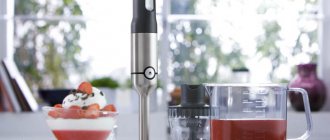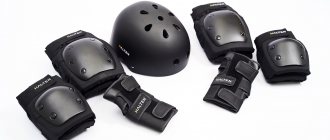A modern kitchen is not only about exquisite furniture, impeccable design and comfortable furnishings. Reliable and functional household appliances have long become familiar inhabitants of dining rooms, helping in the preparation of dishes and making the housewife's work easier. Powerful, practical and compact devices perform a variety of tasks quickly and efficiently. Everything that previously had to be done manually is now automated and brought to perfection. Exquisite delicacies can be served to the table in a matter of seconds, surprising your loved ones and guests who drop in for a moment with the skill. One of the very first inventions to become incredibly widespread was the blender. A common modern device has revolutionized cooking, turning the preparation of gourmet dishes into a creative process that does not require much effort. When did the first blender appear and what devices are popular today we will tell further.
The very first blender
In 1922, American Stephen Poplawski came up with a mechanism that could quickly make a portion of soda. The device was an engine with a propeller placed in a steel bowl. Using such a simple device, the inventor mixed water, syrup and carbon dioxide crystals. The simple device has gained immense popularity among bartenders. Thus, bartenders created alcoholic cocktails, avoiding punishment for violating Prohibition.
But it was possible to reveal all the possibilities of the device much later. This happened in 1935. Interested in the invention of Stephen Poplawski, engineer Fred Osius decided to improve the device. The mechanic worked on the new design for about two years. The long and painstaking work was not in vain. The device created by Osius boasted true versatility. Using a blender, you could cut food, chop and grind various ingredients, and make the perfect puree. A little later, in 1950, Roger Parinjak turned the stationary design into a familiar hand or immersion blender, which gained incredible popularity among chefs, bartenders and ordinary housewives.
Since then, the process of improving the design has never stopped, allowing us to discover more and more new possibilities for this universal device. Each manufacturer introduced something new, trying to make an even more advanced model of the popular device. Products became smaller, more productive, more economical and more comfortable. The most practical materials are used for production. The creators do not forget about external design, embodying the most daring ideas and turning devices into works of art.
Blenders.
A blender is an electrical appliance designed for grinding food, preparing emulsions, purees, whipping drinks, mousses, etc., as well as crushing ice.
Translated from English “Blender” means mixer, mixer.
Types of blenders.
There are two options for blender designs:
Stationary blenders. - Usually it is a housing located on a stable base, inside of which there is an electric motor (UKD) - the drive of the blender, onto which a special narrow and high bowl with a lid is placed on top, inside of which there is a paddle knife.
Hand-held immersion blenders equipped for whipping with a paddle-knife attachment.
How and when did the blender appear?
The blender was invented in 1922 by American Stephen Poplawski, with the purpose of mixing water, carbon dioxide crystals and syrup.
The first blenders were a bowl on a stand in which a propeller-shaped blade rotated, and they could only mix.
The first blenders became popular in bars, helped by Prohibition in the United States, where they were used to mix cocktails.
In 1935, another American inventor, Fred Osius, decided to take Poplawski's idea to the next level.
So in 1937, Osius presented to the public a stationary blender in the sense we are familiar with today, that is, capable of not only mixing, but also chopping, grinding and turning food into puree.
To begin mass production of blenders, Fred Osius began looking for investment. Osius decided to contact Fred Waring, who was considered a connoisseur of various technical innovations. The inventor, knowing about this character trait of his future sponsor, sought a meeting with him and finally met him at the Vanderbilt Theater (New York). Waring almost immediately agreed to finance the invention project, knowing the good reputation of the company Osius represented and feeling the benefits of investing in the development of a blender. Waring's investment in the invention project amounted to a little less than $25 thousand, a large amount for those times, but the inventor could not achieve the result desired by the investor.
Six months later, Fred Waring decided to refuse the services of Osius and continue to work on developing a prototype of the device on his own. Already in 1937, at one of the thematic exhibitions, Fred Waring presented his own expanded and modified concept of the device, which he called Miracle Blender.
In 1938, a convenient and productive new kitchen appliance was named after its creator, the Waring Blender. The retail price of the new product was just under $30, thanks to which many US residents could afford it.
Waring was confident in the success of the invention, and quickly achieved success by personally advertising his blender to restaurants and hotels.
Blenders quickly gained popularity, and already in 1954 its millionth copy was sold.
The next step in the development of the idea of mixing products was taken in Switzerland.
In 1950, inventor Roger Perinjacquet patented the device that later became known as the hand, stick or immersion blender, and gave it the name “bamix” (from the combination of the French words battre and mixer, that is, “beat” and “mix”). In 1955, the device was demonstrated at the international exhibition in Hanover, after which its rapid journey around the world began.
From that moment on, the blender was accepted by professional chefs as a must-have kitchen equipment, along with a knife, saucepan and colander. It is very likely that without it, a modern kitchen would be, at a minimum, much more boring.
Equally important, the design of the immersion blender is an open system. Remove the knife from it, attach the whisk - you can beat the whites.
Modern blenders.
Blenders are widely represented in the range of modern kitchen appliances. Engineers are coming up with new designs for such devices. For example, hand blenders with sets of removable attachments. In fact, it’s already a food processor turned inside out. And, as a rule, not as powerful as a real food processor, but it is compact.
Blender. The history of the blender.
Women's site: I-the-most-beautiful.rf (www.i-kiss.ru)
How to choose the best blender
The choice is always individual. It depends on what tasks the owner faces. Modern manufacturers produce devices of varying power and functionality. The only important condition is the quality of the device. A reliable blender, made of durable and lightweight materials, will ensure long and safe operation, helping you create culinary masterpieces. The German company Braun is rightfully proud of the quality of its equipment. The wide range of Braun blenders allows you to make an individual choice without worrying about the performance and reliability of the device. The company actively applies the latest industry achievements and is engaged in independent developments designed to improve the functionality of equipment. Therefore, every Braun blender is a devoted and impeccable fulfiller of its owner’s wishes.
The history of blender creation
The times are over when you had to shed your tears over a board, when you have to peel onions or cut them into small pieces, or spend a lot of time cutting boiled vegetables for your child through a strainer. Today there is such a device as a blender, with which the same work can be done in seconds. You can also purchase more dishes here https://tescoma-best.ru/.
This kitchen assistant was invented almost 100 years ago by US resident Stephen Poplawski. The world's very first blender was used for liquids, then it gained popularity in cocktails. The rest of the progress was not made by him. 20 years later, the newly invented blender became a hit at a restaurant equipment show in Chicago. The owners of wine companies were most interested in the new product, and all because to prepare high-quality champagne, it needs to be mixed very well. Blenders began to mix and grind grapes, then grape juice, which was fermented, better than all the bartenders combined. After this, the winemakers produced truly high-quality champagne – blended champagne. And still, blenders did not become kitchen appliances even then.
After this, the food processor was invented sometime in the 1970s. This design was invented and assembled by US native Carl Sotheimer. People remembered about blenders quite recently - about 20 years ago, and all because of baby food and high-quality, quick grinding of food. At the same time, a food processor is clearly not suitable for chopping - it does not fit as much as a blender can. At this time the blender was reborn. It has become number one for all types of purees and the best device for preparing baby food. And some manufacturers of blenders began to cheat - they added a special device - a chopper, which is designed for one glass of the prepared mixture.
Home » Miscellaneous » The history of the blender
Related materials:
Kitchen furniture - new opportunities for creating comfort in the kitchen Today, any housewife tries to make the kitchen the most unique and attractive solution. After all, a kitchen is not just a room where people cook... The Hobbit: An Unexpected Journey. From creation to plot. The story of the One Ring, created by John Ronald Reuel Tolkien, has captured the hearts of many fantasy lovers. And back in 2001, under... Purposes of purchasing kitchen furniture When a housewife often cooks something, then she wants the kitchen to be comfortable, practical and at the same time multifunctional. Every manufacturer in... Why send your child to a dance school? Extracurricular activities will always have a positive effect on both boys and girls. There are a large number of sections where they equally want... Products for styling short hair There are many different substances for styling hair and their compositions should be divided into three types: modeling, fixing and combined. Now …
Combination blender
Some manufacturers produce combined models. In such devices, a stationary bowl with knives is additionally attached to the hand immersion blender.
Other kits may also include a chopper, steamer and soup maker. This versatility actually turns the blender into a food processor. This affects its large size and high cost.
Stationary blender
The principle of operation of the electrical device is autonomous operation. The blender consists of a body with a motor on which a container is installed. The housing can be small or medium in size and is usually placed on a flat surface.
Can be made of plastic or metal. The filling container can be glass or plastic. Volumes can be from 350 ml to 2 liters depending on the model.
Some manufacturers additionally include a small glass of 200 ml. For a stationary model, it is necessary to allocate a separate place on the countertop during operation, and, if necessary, in the closet during storage.
Philips blenders
- high quality;
- reliable assembly;
- stylish design;
- maximum power;
- Availability of vacuum technology.
When choosing a Philips stationary blender, you can pay attention to the HR3752, HR2604 models with a power of 1400 W and a cost of 4190 rubles.
Of the immersion blenders, the HR 1679 model with a power of 800 W and a price starting from 11,659 rubles is at the top in the ratings.
Among Russian manufacturers, Kitfort and Redmond are gaining popularity.
The history of the blender
This device was first created in the 20s in America for mixing the ingredients for a carbonated drink with syrup. Initially, the invention was a great success among bartenders. During Prohibition in the United States, cocktails that required thorough mixing or whipping were prepared using a blender.
Initially, the electrical appliance consisted of a wide bowl, at the bottom of which a propeller-shaped knife rotated. The mechanism was driven by an electric motor located in a special housing on which the bowl was attached.
In the 50s, Swiss developers introduced hand blenders of a more compact size. These inventions have finally won their place in restaurant kitchens and in everyday life, replacing the mixer and bulky food processor.











